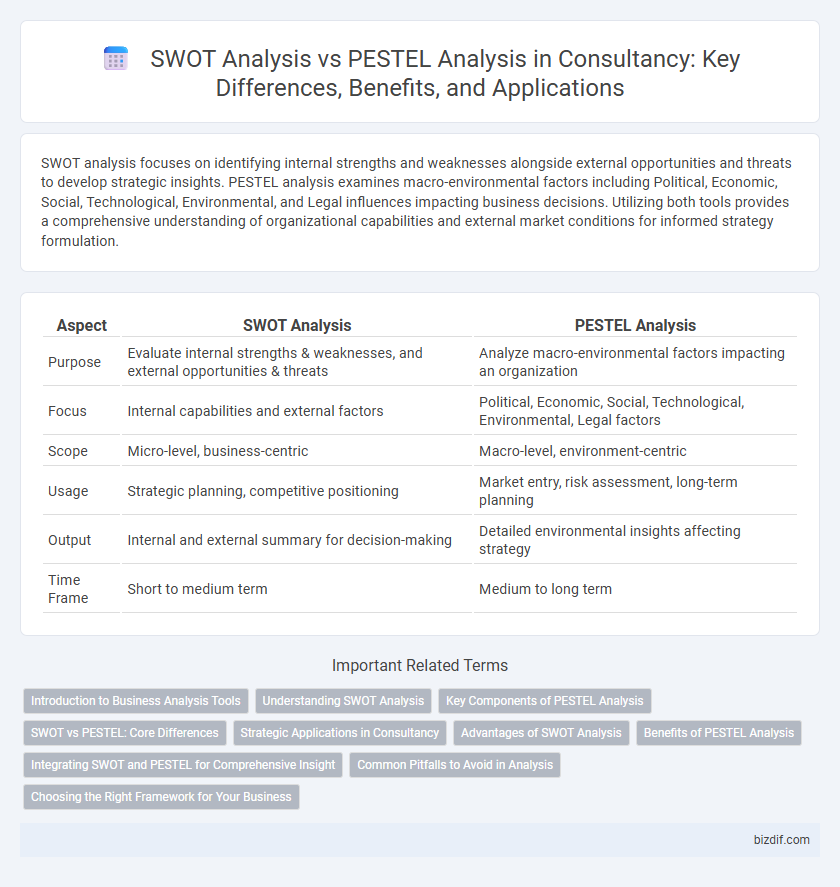SWOT analysis focuses on identifying internal strengths and weaknesses alongside external opportunities and threats to develop strategic insights. PESTEL analysis examines macro-environmental factors including Political, Economic, Social, Technological, Environmental, and Legal influences impacting business decisions. Utilizing both tools provides a comprehensive understanding of organizational capabilities and external market conditions for informed strategy formulation.
Table of Comparison
| Aspect | SWOT Analysis | PESTEL Analysis |
|---|---|---|
| Purpose | Evaluate internal strengths & weaknesses, and external opportunities & threats | Analyze macro-environmental factors impacting an organization |
| Focus | Internal capabilities and external factors | Political, Economic, Social, Technological, Environmental, Legal factors |
| Scope | Micro-level, business-centric | Macro-level, environment-centric |
| Usage | Strategic planning, competitive positioning | Market entry, risk assessment, long-term planning |
| Output | Internal and external summary for decision-making | Detailed environmental insights affecting strategy |
| Time Frame | Short to medium term | Medium to long term |
Introduction to Business Analysis Tools
SWOT Analysis evaluates internal strengths and weaknesses alongside external opportunities and threats, providing a comprehensive view of a company's strategic position. PESTEL Analysis examines macro-environmental factors--Political, Economic, Social, Technological, Environmental, and Legal--that impact business operations and decision-making processes. Both tools are essential in consultancy for identifying key influences on business performance and guiding strategic planning.
Understanding SWOT Analysis
SWOT analysis identifies internal strengths and weaknesses alongside external opportunities and threats, enabling businesses to leverage competitive advantages and address vulnerabilities. It synthesizes qualitative and quantitative data from market trends, financial performance, and operational capabilities to guide strategic decision-making. Unlike PESTEL analysis, which examines macro-environmental factors, SWOT provides a focused framework for evaluating company-specific dynamics.
Key Components of PESTEL Analysis
PESTEL analysis identifies Political, Economic, Social, Technological, Environmental, and Legal factors shaping business environments, offering a comprehensive external assessment. Unlike SWOT, which maps strengths, weaknesses, opportunities, and threats, PESTEL provides strategic insights into macro-environmental influences crucial for long-term planning. Key components like regulatory changes, economic trends, social demographics, and technological innovations enable consultants to anticipate risks and capitalize on external opportunities effectively.
SWOT vs PESTEL: Core Differences
SWOT analysis evaluates internal strengths and weaknesses along with external opportunities and threats, providing a comprehensive view for strategic planning. PESTEL analysis focuses exclusively on external macro-environmental factors: Political, Economic, Social, Technological, Environmental, and Legal influences impacting an organization. Understanding SWOT's internal-external scope versus PESTEL's external macro perspective helps consultants tailor strategies based on organizational readiness and environmental conditions.
Strategic Applications in Consultancy
SWOT Analysis provides consultants with a structured framework to evaluate internal strengths and weaknesses alongside external opportunities and threats, facilitating targeted strategic planning. PESTEL Analysis complements this by examining macro-environmental factors--Political, Economic, Social, Technological, Environmental, and Legal--that impact organizational strategy and market positioning. Leveraging both tools enables consultants to deliver comprehensive insights that drive informed decision-making and effective competitive advantage strategies.
Advantages of SWOT Analysis
SWOT Analysis offers a clear framework to identify and evaluate internal strengths and weaknesses alongside external opportunities and threats, enabling targeted strategic planning. Its simplicity and adaptability allow consultants to quickly assess organizational factors, facilitating actionable insights without extensive data requirements. Compared to PESTEL Analysis, SWOT provides a more direct link to actionable business decisions by focusing on factors within the company's control and immediate environment.
Benefits of PESTEL Analysis
PESTEL analysis provides a comprehensive evaluation of external macro-environmental factors including Political, Economic, Social, Technological, Environmental, and Legal influences that impact business strategy. By identifying opportunities and threats stemming from these external forces, organizations can proactively adapt to market changes and regulatory shifts. This broad perspective facilitates strategic planning and risk management more effectively than a SWOT analysis, which primarily focuses on internal factors and immediate competitive positioning.
Integrating SWOT and PESTEL for Comprehensive Insight
Integrating SWOT and PESTEL analysis enhances strategic consultancy by combining internal strengths and weaknesses with external political, economic, social, technological, environmental, and legal factors. This holistic approach enables businesses to identify opportunities and threats while aligning them with core capabilities and market conditions. Leveraging both frameworks together facilitates comprehensive decision-making and adaptive strategies in dynamic business environments.
Common Pitfalls to Avoid in Analysis
Common pitfalls in SWOT analysis include vague or overly broad categories that obscure actionable insights, while PESTEL analysis often suffers from neglecting the dynamic interplay between political, economic, social, technological, environmental, and legal factors. Both analyses can fail if data sources are outdated or biased, leading to misinformed strategic decisions. Ensuring thorough, current research and clear differentiation between internal (SWOT) and external (PESTEL) factors enhances the quality and applicability of the findings.
Choosing the Right Framework for Your Business
SWOT Analysis evaluates internal strengths and weaknesses alongside external opportunities and threats, offering a clear snapshot of your business capabilities and strategic challenges. PESTEL Analysis examines macro-environmental factors--Political, Economic, Social, Technological, Environmental, and Legal--that can impact industry dynamics and long-term planning. Selecting the right framework depends on your business needs: use SWOT for internal strategy development and PESTEL for understanding broader external influences shaping market conditions.
SWOT Analysis vs PESTEL Analysis Infographic

 bizdif.com
bizdif.com